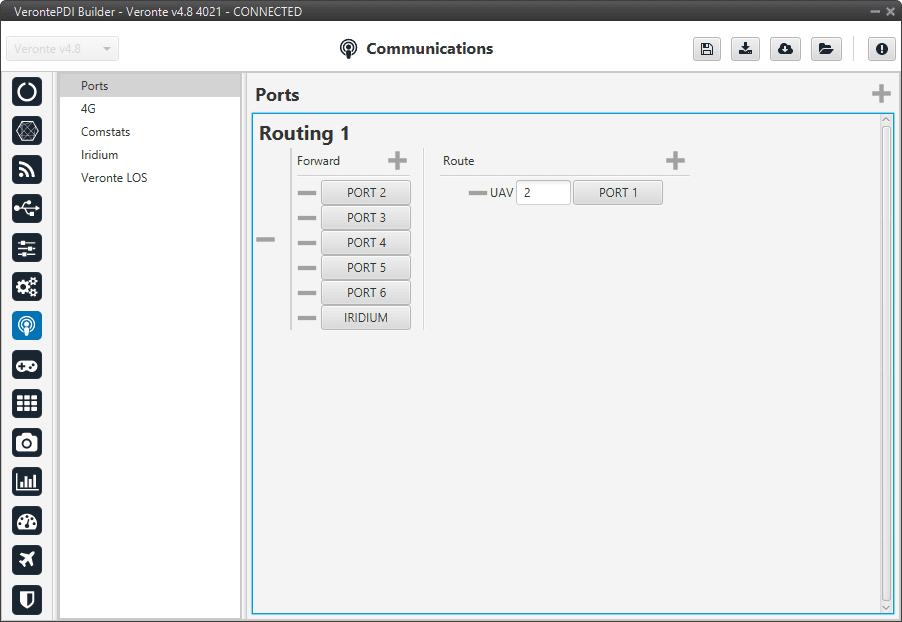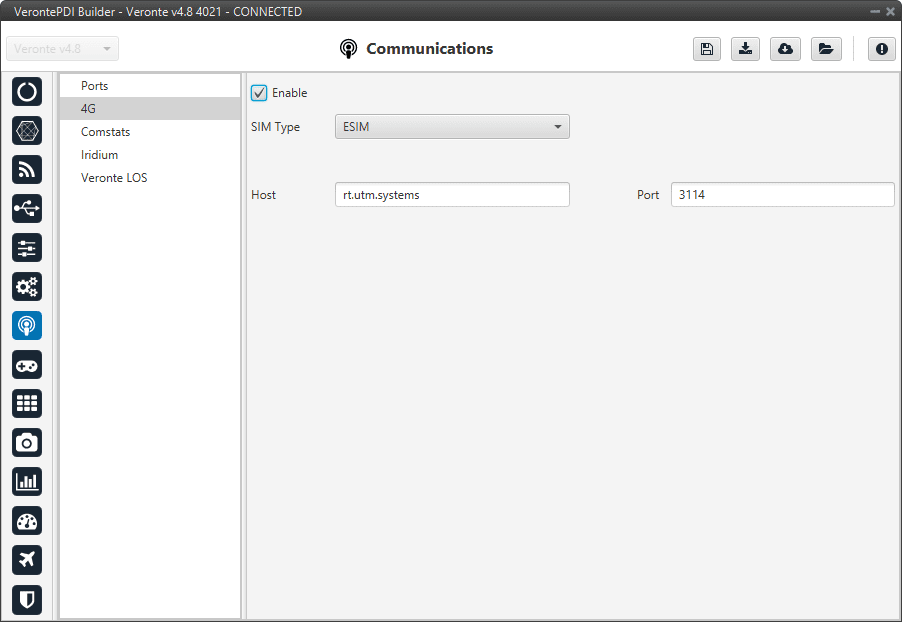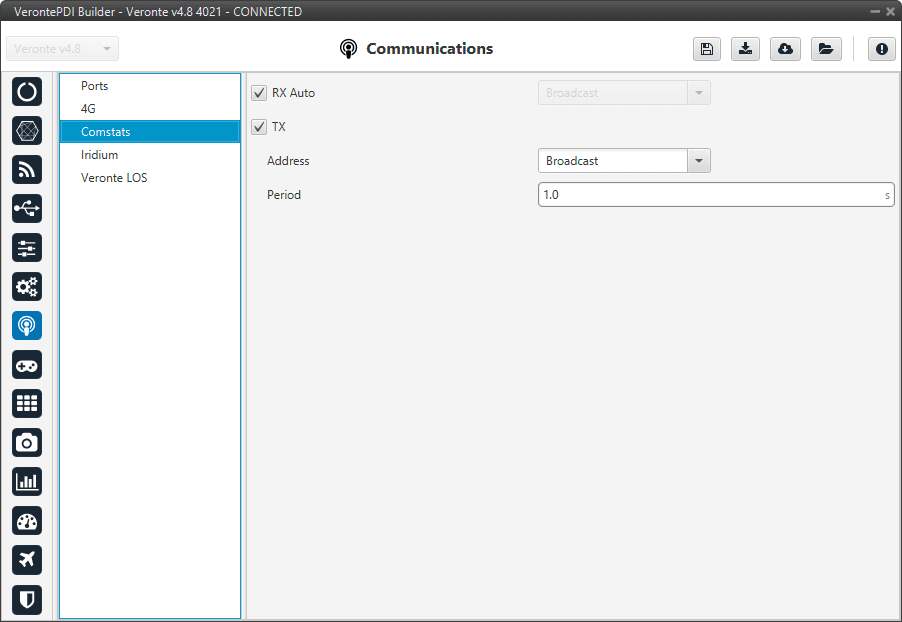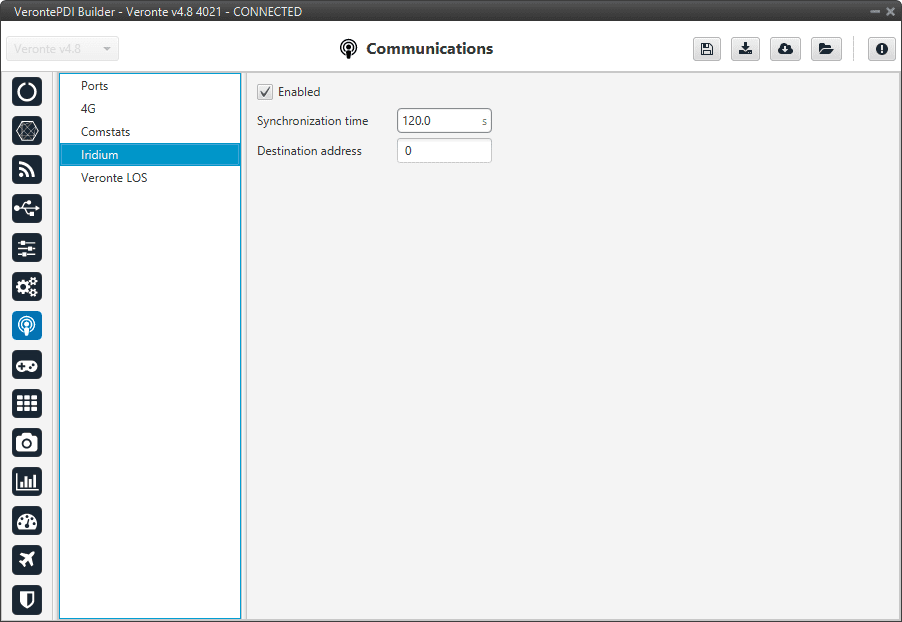 Communications¶
Communications¶
Ports¶
Ports configuration allows the user to configure which communication ports (Commgr Ports in I/O setup) will be used for communication. When using the Route feature, 1x autopilot can be configured to route VCP messages for an external Veronte device with a known address (ID) through a given port.

Ports menu¶
Each of the different ports can be configured as either of the following options:
Forward: Any messages generated by this unit (i.e. Telemetry or response messages to certain commands) will be sent through these ports.
Route: Any messages received at any Commgr Port with the defined address will be re-sent through the defined port. It is possible to route several addresses through the same port, but is not possible to route the same address through several ports. Only the first configured port will be used. Routing also applies to messages generated by the unit for the defined address.
Note
The same port cannot be used as Forward and Route at the same time.
It is possible to define up to 4 routing setups, which can be switched unsing the Ports action of the Automations menu. Routing 1 will always be selected by default when booting 1x autopilot.
Application example
A practical example of the use of this menu are 1x Ground unit configurations. These configurations will have configured a Routing of Address 2 (1x PDI Builder) through Port 1. This way, any messages that are received through a Commgr Port (i.e. through Veronte LOS), will be re-routed through Port 1 (USB) and received by 1x PDI Builder Software, including any messages generated by 1x Ground unit itself.
Warning
An incorrect Port configuration can disable USB communication. If this happens, 1x will not be able to be detected through Veronte Link software. If this is the case, please visit Maintenance mode - Troubleshooting section.
4G¶
Checking the Enable box will enable the use of 4G communication through the Veronte LTE Consumer/Producer in the I/O setup.
ESIM
The embebed ESIM in 1x autopilot allows the user to send and receive telemetry using a commercial data provider.
The connection between the air unit and the ground station is stablished through the Veronte Cloud server. To connect with Veronte Cloud the following parameters have to be set:
Host: rt.utm.systems
Port: 3114
Host and Port can be changed if the used server differs from Veronte Cloud, but the communication protocol does not change.

ESIM menu¶
Note
In order to use the embedded SIM card, the contract with the data supplier needs to be done through Embention. Please contact sales@embention.com for more information on availability, coverage, suppliers and prices in your country.
SIM
If needed it is also possible to install a custom SIM card on 1x autopilot. PIN number and APN (Access Point Name) of the SIM card provider must be defined before enabling the 4G communication

SIM menu¶
Warning
Introducing the wrong PIN number may block the SIM card.
The installation of the SIM card must be done by Embention during the production of the unit. Please make sure to indicate the interest on using a Custom SIM card when ordering new 1x units.
Comstats¶
The Comstats feature allows 1x autopilot to make an estimation of the overall quality of the communication channel.
1x will send periodically (If enabled) a message with its current communication statistics (Packets sent and received per second). Then, any other 1x unit can receive this information and compare against its own statistics to estimate the average amount of packets lost in the communication.
The results of this estimation can be monitored in variables RX Packet Error Rate (ID 2000) and TX Packet Error Rate (ID 2001). These variables can be used to enable, for example, failsafe actions in case of degradation or loss of communications.

Comstats menu¶
It is possible to configure the source or destination of the statistics, as well as the frequency at which the Comstats message is sent:
RX Auto: Enabling this option will use the first remote AP found. If this option is disabled, the user must choose manually the address of the unit used for Comstats calculation.
TX: When enabled, the unit will periodically send its Comstats message (set the period). Select the address to which the message should be sent:
App 2: Veronte Ops address.
Broadcast: All units on the network.
Veronte v4.X XXXX: To a specific unit.
Note
Enabling Tx will enable autopilot to send its Comstats message, but in order to compute Packet Error rate it’s necessary to receive the TX message from a different unit.
Warning
Packet error rate is a good indicator of the status of the communication, but it is not representative of the radiolink status. For monitoring the status of the radiolink RSSI Variables (820-822) shall be used instead. Depending on the configuration it is posible to have bad Error rates with good RSSI (overloaded radiolink) or good Error rates with bad RSSI (degraded communication with low load on radiolink). For the best results, it is recommended to use a combination of both statistics for failsafe automations.
Iridium¶
Checking the Enable box will enable the use of Iridium communication through the Iridium Consumer/Producer in the I/O setup.
Warning
Before using the module, the user will have to register both of them (sender/receiver) in the RockBlock website. Please find more information about the registration process in this link: https://docs.rockblock.rock7.com/docs/rockblock-management-system.

Iridium menu¶
In this menu the following parameters have to be set:
Synchronization time: This is the transmission period, i.e., the time between 2 consecutive messages. This is a parameter that the user should configure taking into consideration its mission.
Destination address: SN (Serial Number) of the destination Iridium module.
Note
To configure the syncronization time, it would be advisable to think about how the user want to use the Iridium communication. The user will pay for credits, and each credit means one message. Each individual message has to be paid, so the syncronization time can be configured in order not to run out of credits.
Veronte LOS¶
In this section, the serial port that communicates from the microcontroller to the internal radio is configured.
Warning
If the user changes the baudrate on the internal radio, it is also required to change it here and vice versa.

Veronte LOS menu¶
Baudrate: This specifies how fast data is sent over a serial line.
Length: This defines the number of data bits in each character: 4 to 8 bits.
Stop: Number of stop bits sent at the end of every character: 1, 1.5, 2.
Parity: Is a method of detecting errors in transmission. When parity is used with a serial port, an extra data bit is sent with each data character, arranged so that the number of 1 bits in each character, including the parity bit. Disabled, odd or even.
Note
All these settings are already specified for a given device, therefore, 1x autopilot should match with them in order to be able to communicate.
